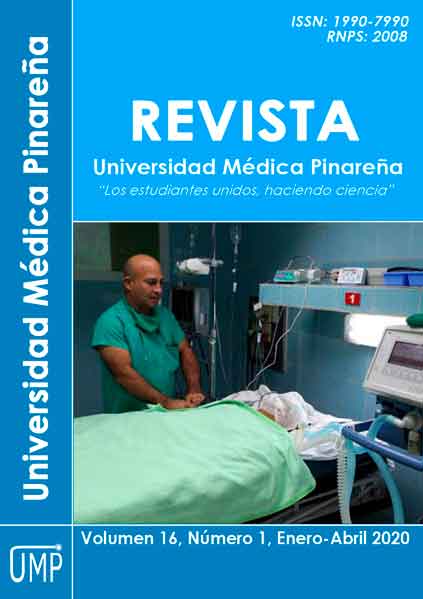Behavior of diabetic ketoacidosis in an Intensive Care Unit
Keywords:
Diabetic Ketoacidosis, Ketosis, Diabetes Mellitus, Intensive Care UnitsAbstract
Introduction: diabetes mellitus is a health problem, having an impact on all systems and which can trigger episodes of diabetic ketoacidosis.
Objective: to characterize clinically and epidemiologically the patients with diabetic ketoacidosis admitted to the Intensive Care Unit.
Methods: an observational, descriptive and cross-sectional study was conducted in patients diagnosed with diabetic ketoacidosis. The target group comprised 37 patients; all of them were included in the study. The variables were processed in the statistical package SPSS version 21 and descriptive statistical methods were applied.
Results: patients between 31 and 40 years of age (37,84 %) and female gender (64,86 %) predominated, with an average age of 34,5 ± 5.71 years; 100 % of the patients presented dry mucous membranes, polypnea and tachycardia. Pneumonia (64,86 %) and urinary tract infection (54,05 %) prevailed as triggering causes. Shock was the main complication related to diabetes mellitus (27,03 %). Patients with moderate ketoacidosis were the majority (51,35 %).
Conclusions: diabetic patients, between the second and third decade of life, and mostly female gender are prone to suffer from diabetic ketoacidosis. Clinically they manifest with dryness of the mucous membranes, polypnea and tachycardia mainly. Pneumonia and urinary tract infections are frequent triggering factors, shock is the main complication; patients with moderate ketoacidosis represented the greater numbers.
Downloads
References
2. Noya Chaveco ME, Moya González NL. Diabetes Mellitus. En: Sánchez Ferrán T, Quesada Pantoja J, Mujica Ruiz J, et al, editores. Reinaldo Roca Goderich Temas de Medicina Interna. Vol 1. 5ta ed. La Habana: Editorial Ciencias Médicas; 2017: p. 224-318.
3. Jefferies CA, Nakhla M, Derraik JG, Gunn AJ, Daneman D, Cutfield WS. Preventing Diabetic Ketoacidosis. Pediatr Clin N Am [Internet]. 2015 [citado 29 septiembre 2019]; 62:857–871. Diaponible en: https://www.sciencedirect.com/science/article/pii/S0031395515000425?via%3Dihub
4. López Simarro F, Redondo Margüello E, Mediavilla Bravo JJ, Soriano Llora T, Iturralde Iriso J, Hormigo Pozo A. Prevención y tratamiento de la enfermedad infecciosa en personas con diabetes. Semergen [Internet]. 2019; [citado 29 septiembre 2019]; 45(2):117---127. Disponible en: https://www.sciencedirect.com/science/article/pii/S1138359318304192?via%3Dihub
5. Ministerio de Salud Pública. Dirección de Registros Médicos y Estadísticas de salud. Anuario Estadístico de Salud 2018 [Internet]. 2019 abr [citado 29 septiembre 2019]. [aprox. 193 p.]. Disponible en: http://files.sld.cu/bvscuba/files/2019/04/Anuario-Electr%C3%B3nico-Espa%C3%B1ol-2018-ed-2019-compressed.pdf
6. Dirección Provincial de Salud Pública de Artemisa. Departamento de Estadística. Dispensarización, incidencia y prevalencia del 2018; 2019.
7. Castaño M, Lopera A, Tobón S, Velasquez M. Diabetes Mellitus en pacientes con infarto agudo de miocardio en un hospital de alto nivel de complejidad de la ciudad de Medellín. MEDICINA UBP [Internet]. 2012 [citado 29 septiembre 2019]; 29(1): 41-45. Disponible en: https://revistas.upb.edu.co/index.php/Medicina/article/view/651
8. Martín Guerra JM, Martín Asenjoa M, Tellería Gómez P, Iglesias Pérez C. Cetoacidosis diabética como guía diagnóstica: Caso clínico. Rev. Med. Clin. Condes [Internet]. 2019; [citado 29 septiembre 2019]; 30(4) 323-325. Disponible en: https://www.sciencedirect.com/science/article/pii/S0716864019300604
9. Umpierrez GE. SGLT2 inhibitors and diabetic ketoacidosis: A growing concern. Nature Review Endocrinol [Internet]. 2017; [citado 29 septiembre 2019]; 13:441–2. Disponible en: https://www.nature.com/articles/nrendo.2017.77
10. Martín Asenjo M, Martín Guerra JM, Prieto de Paula JM. Cetoacidosis diabética por empaglifozinay obstrucción intestinal. La importanciade la gasometría arterial. Med Clin (Barc) [Internet]. 2018; [citado 29 septiembre 2019]; 150(10):410–411. Disponible en: https://doi.org/10.1016/j.medcli.2017.10.023
11. Moreno Obregón F, et al. Cetoacidosis diabética grave, fracaso renal agudo y deshidratación por canagliflozina en paciente con diabetes mellitus tipo 2: presentación clínica atípica. Aten Primaria [Internet]. 2019. [citado 29 septiembre 2019]; 58(3):35-41 Disponible en: https://doi.org/10.1016/j.aprim.2019.04.007
12. Fier BM. Hypoglycaemia in diabetes mellitus: epidemiology and clinical implications. Nat Rev Endocrinol [Internet]. 2014 [citado 29 septiembre 2019]; 10:711-22. Disponible en: https://www.nature.com/articles/nrendo.2014.170
13. Vich Pérez P, Mora Navarro G, Espejo González A, López Fernández M. Diabetes mellitus tipo LADA y cetoacidosis: reflexiones a partir de un caso clínico. Semergen [Internet]. 2018; [citado 29 septiembre 2019]; 44(1):64-70. Disponible en: https://doi.org/10.1016/j.semerg.2017.05.005
14. Del Villar Guerra P, de Luis Román D, González Sagradoc M, del Villar Galán R. Descripción de las características de la cetoacidosis diabética al inicio en una muestra de pacientes con diabetes mellitus tipo 1. Cartas científicas / Med Clin (Barc) [Internet]. 2015; [citado 29 septiembre 2019]; 144(6):279–281. Disponible en: http://dx.doi.org/10.1016/j.medcli.2014.05.028
15. López Simarro F, Redondo Margüello E, Mediavilla Bravo JJ, Soriano Llorab T, Iturralde Iriso J, Hormigo Pozo A. Prevención y tratamiento de la enfermedad infecciosa en personas con diabetes. Semergen [Internet]. 2019; [citado 29 septiembre 2019]; 45(2):117-127. Disponible en: https://doi.org/10.1016/j.semerg.2018.07.007







